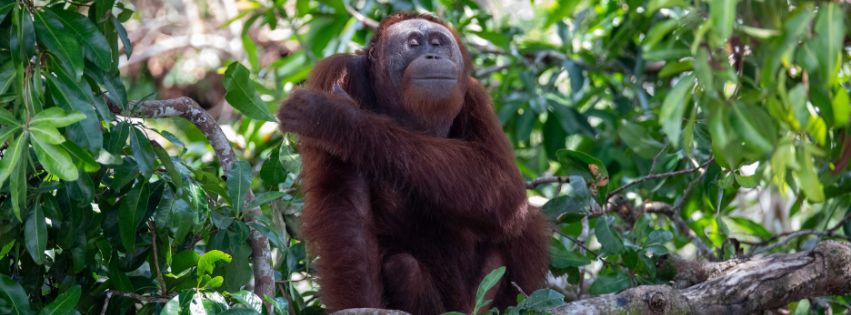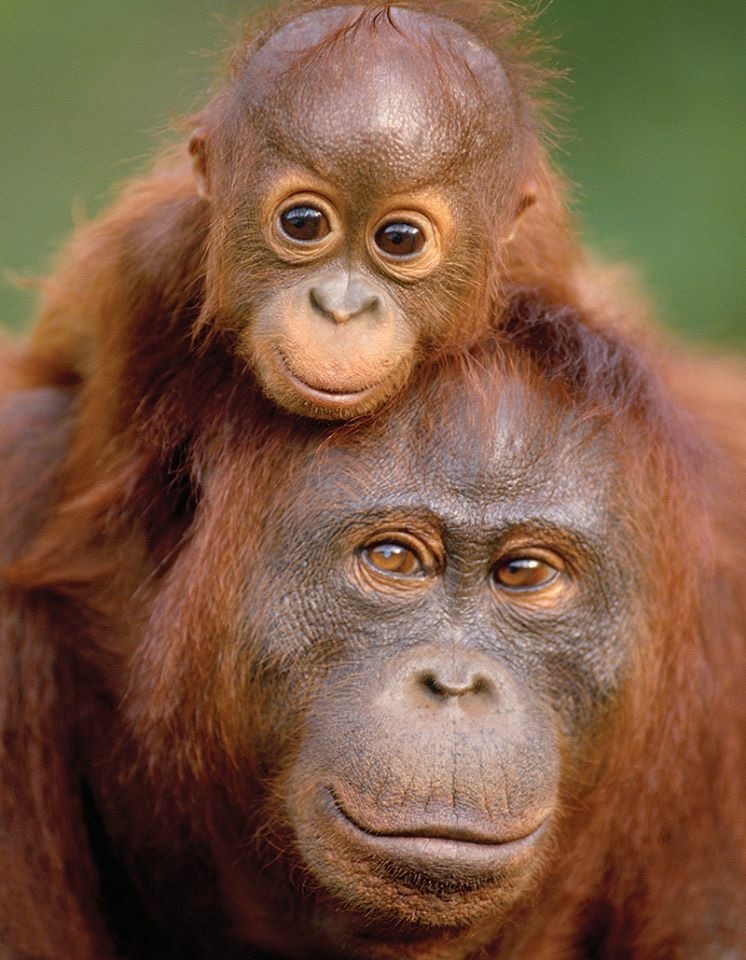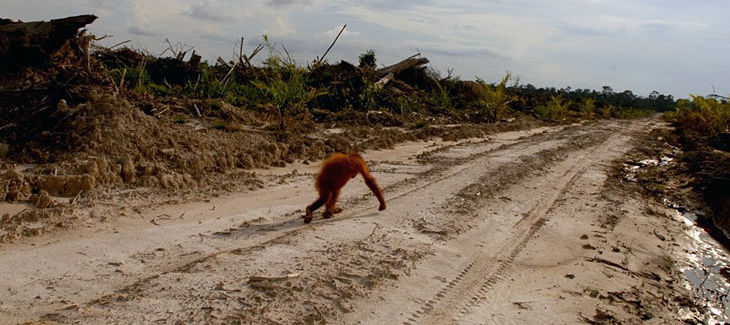Orangutan Facts & Figures
Below you can find some facts about orangutans and forests. Remember that the numbers are estimates. Exact figures vary depending on the species

Average height standing up:
Male 4 1/2 feet;
Female 3 1/2 feet.
Their arms are much longer than their legs.
The arm span for large males can be up to 8 feet.
Average weight:
Adult male 200 to 250+ lbs.
Adult female 100 – 150 lbs.
On average, females are 1/3 to 1/2 the size of males
Average lifespan:
Estimated 35-40 years in the wild, into their 50s in captivity– depending on diet and exercise.
Number of babies:
One at a time, every 6 or 7 years, perhaps as many as 4 or 5 total.
Infants stay their mothers until 9-10 years old.
Babies nurse until they are about 6 or 7 years old. They have the longest dependence of any animal on earth.
Young males begin to break away from their mothers after they, themselves, reach puberty. Females stay with their mothers longer, often learning child-rearing skills from her.
Social status:
Grown males live alone while females live with their young.
Even though they reach puberty at about 8 years old, a female isn’t physiologically ready to have her own baby until she’s in her teens.
Their diet consists of bark, leaves, flowers, a variety of insects, and most importantly, several hundred types of fruit. They can eat fruit which we would consider unripe, giving them an advantage over other fruits eaters.
Babies need to learn to recognize hundreds of species of plants and trees– which ones are edible, and how to consume them, which ones to avoid. Some orangutan favorites are very difficult to eat because they are protected by sharp spines husks and shells. Young orangutans need to be taught how to extract the fruit.
Orangutans can be said to have 4 hands, as they are equally capable with both their hands and feet.
They are physically built for life in the trees. Walking on the ground can be somewhat slow and awkward for them. It may appear humorous to us, but imagine how we would look trying to get around in the trees. They are at a great disadvantage on the ground, so they rarely come down from the treetops. Predators– including humans– are on the ground. In essence, everything they need to live is up there, so why come down?
Sexually mature males have a large throat sac, which is used to make a very distinct sound: known as the ‘long call’. Sort of like a lion’s roar, this bellowing groan echoes through the forest and is used by males to let females know they are there or warn other males to keep away. Mature males also have a distinct set of large cheekpads, which are believed to help their long call resonate throughout the forest canopy.
Orangutans make their home high up in the trees and build new nests each night out of leaves and branches.
Males live solitary lives until they find females who are ready to mate. The couples stay together for several days in order to ensure a successful mating. Afterwards, the males disappear back into their solitude.
Due to their large size, males are often too heavy to travel in the higher (thinner) branches. They are also more likely than females to travel on the ground.
Food is often scarce during the dry season– which is why orangutans are semi-solitary creatures. When food is abundant, though, they use the opportunity to socialize and gather in small groups. When food is scarce, they travel alone.
Orangutans have been known to make and use tools. When water is difficult to locate, they chew leaves to make a sponge to soak up water in tree cavities. They use branches to poke into termite holes. They use large branches to test water depth before crossing streams. When it rains very hard the orangutan makes an umbrella for himself out of big leaves.

Fact Sheet: Threats
The main threats: destruction of the rainforest due mainly to encroaching palm oil plantations, illegal logging, fires and poaching
Borneo: the worlds third largest island Surface: 462,000 sq miles
Reduction of the forest: Since 1980 more than 50% of Borneo’s forests have disappeared.
Human population: more than 15 million
Nations: Borneo is divided between three countries: Indonesia, Malaysia and Brunei
The orangutans used to live spread out over South East Asia all the way to what is now southern China. Most of the land was then covered with huge continuous rainforest areas and the orangutans could roam freely over large distances. Today the logging and the human expansion have limited the untouched rainforest to very little intact areas. The numbers of orangutans are diminishing because of human impact. The threat comes mainly from three human activities: destruction of the forest, fires and poaching. Large parts of the original forests of Asia have disappeared. They have been replaced by farm land, palm oil plantations, cities and villages. Huge areas are also disappearing as the forest companies are illegally cutting down the trees, without permits from either the government or the local populations, who depend on the forest for their survival. When creating plantations it is common to first burn the land. Over the years these planned fires have often spread uncontrollably, leaving an enormous destruction in their wake. Many orangutans are killed by the fires as they have no chance of escape. The poaching of the orangutan is another obstacle for the survival of the species. The infants are sold as exotic pets while the flesh from the adults is eaten. Despite the fact that it is illegal to kill, capture or sell orangutans there is a lot of money to be made-- which makes it very difficult to come to terms with the problem.
Fact Sheet: Rainforests
Surface of Indonesia: 1,192,684 sq miles Forest: 550.000 sq miles
Rate of logging: Ca 12,500 sq miles per year.
Threat: Forest destruction and fires. Illegal logging: Estimated to constitute 50 - 88% of all logging.
Only in Borneo you can find 10 - 15,000 different species of flowers and around 3000 different kinds of trees. The same diversity applies to the animals and a large number are endemic to this area and can be found no where else. Every year new animal and plant species are discovered and scientists barely have time to investigate before they disappear forever. The Indonesian rainforest is the second largest in the world with an area of nearly 546.806 square miles. This is about 10% of the world’s rainforest and is twice the size of Texas or nearly the size of Alaska. Logging and fires are making the forest disappear at an unsustainable rate. Hundreds of animals and plants are disappearing because of this and entire ecosystems are transformed into desert. One of the biggest problems in Indonesia is the illegal logging that is being fueled by the international demand for cheap timber. There are different opinions as to the extent of the illegal logging, but is it clear that more than half of all logging in the country is illegal.
Saving orangutans is built on the premise of protecting and preserving the rainforest. This is not only decisive for the orangutans but also for thousands of other threatened animal and plants species.
Please help the orangutans today.
